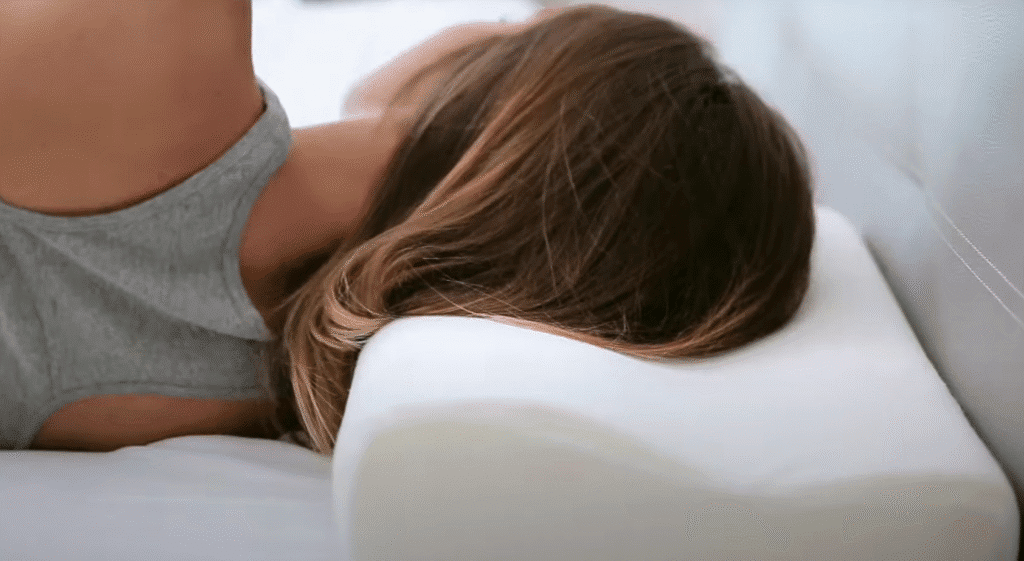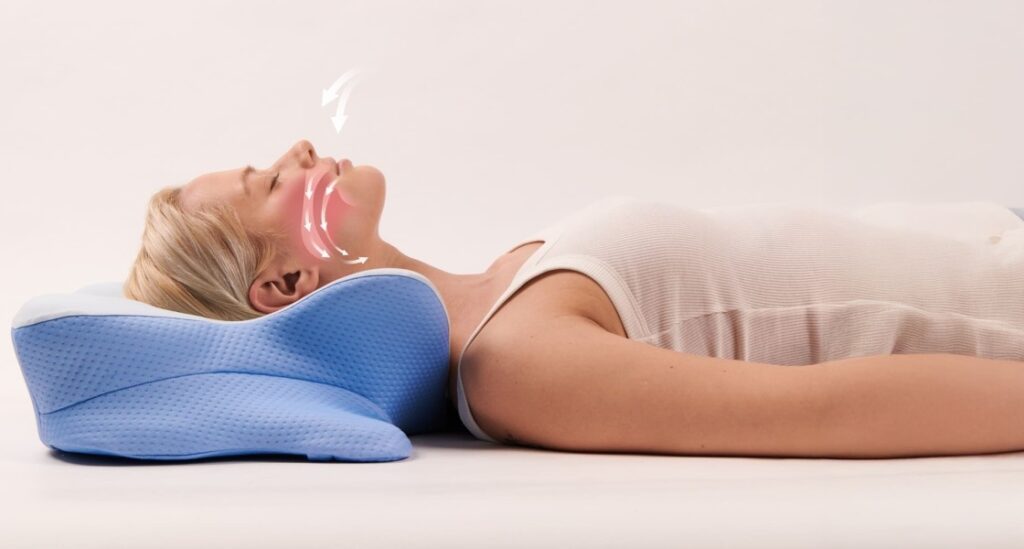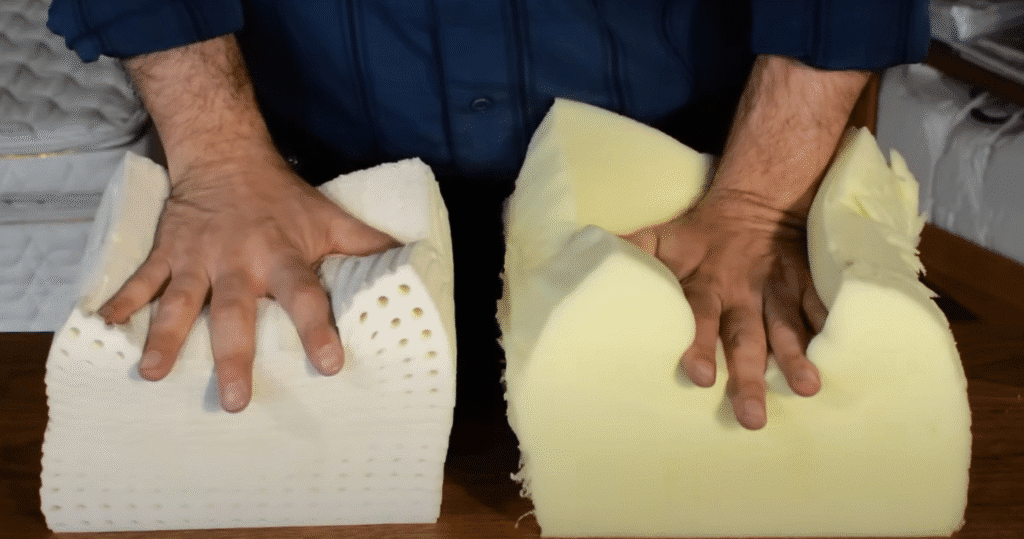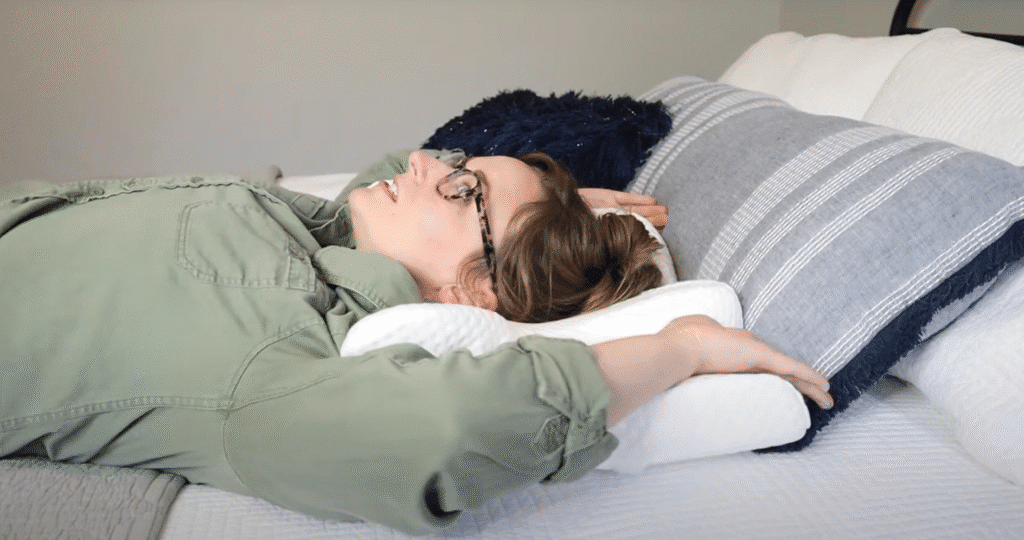Are Memory Foam Pillows Good for Neck Pain?
Do you wake up every morning with a stiff, aching neck? That familiar tinge of pain as you try to turn your head might be linked to something you haven’t considered – your pillow. For the thousands of people searching for neck pain relief, memory foam pillows often appear as a potential solution. But how well do they work?
In this article, we’ll explore whether memory foam pillows can truly help alleviate neck pain, examine their benefits and drawbacks, and provide practical advice for finding the right pillow for your specific needs.

Disclosure: This post contains affiliate links. We may earn a small commission on qualifying purchases at no additional cost to you.
Key Takeaways
- Memory foam pillows can help reduce neck pain by conforming to your unique shape and maintaining proper spinal alignment
- The ideal pillow height depends on your sleeping position: higher for side sleepers, medium for back sleepers, and lower for stomach sleepers
- The Derila pillow features a revolutionary butterfly design with support wings that cradle the head and neck while preventing numb arms
- Quality memory foam provides consistent support throughout the night, unlike traditional pillows that flatten or shift
- Potential drawbacks include initial heat retention, off-gassing odors, and a brief adjustment period
- The right memory foam pillow should complement your sleeping position, feel comfortable against your skin, and maintain its supportive properties over time
The Derila Pillow: This Year’s Memory Foam Sensation

You’ve probably spotted the Derila Ergo memory foam pillow in sleep forums or on your social media feed recently.
Unlike standard rectangular pillows—or even basic contoured ones—it has a distinctive butterfly shape with built-in support wings that offer a more tailored feel.
This ergonomic pillow is designed to help ease common sleep disruptors such as neck pain and stiffness, while its sculpted memory-foam core provides more structured support than flatter, conventional pillows.
The curved shape cradles the head while supporting the neck’s natural alignment—something many back and side sleepers look for in a supportive pillow.
Owners also note that the memory foam maintains its shape well even after months of use, and that the material stays cooler than other brands on warm summer nights, avoiding the sweaty “stuck” feeling.
If you’re looking to compare the Derila Ergo to other memory foam or ergonomic pillows, you can read our full review here.
The Science Behind Memory Foam and Neck Support
Memory foam wasn’t originally created for your bedroom. This remarkable material was first developed by NASA in the 1960s to improve seat cushioning and crash protection for astronauts. Its journey from space technology to sleep essential happened because of its unique viscoelastic properties.
When you rest your head on a memory foam pillow, the material responds to your body heat and weight, contouring precisely to the shape of your head and neck. This personalized molding effect creates a customized cradle that many neck pain sufferers find relieving.
The science is straightforward: proper neck alignment during sleep is crucial for preventing pain.
Your cervical spine (the neck region) has a natural curve that needs consistent support throughout the night. Unlike traditional pillows that may flatten or shift, quality memory foam maintains its supportive structure while still conforming to your movements.
Understanding the Connection Between Poor Sleep Posture and Neck Pain

Before deciding whether memory foam pillows are worth the investment, it’s important to understand how poor sleep support can lead to neck discomfort.
When your pillow fails to maintain proper alignment between your head, neck, and spine, muscles remain tensed throughout the night, trying to compensate for the lack of support. This prolonged tension leads to the stiffness and pain you feel in the morning.
Common pillow-related causes of neck pain include:
- Pillows that are too high, forcing your neck to bend unnaturally upward
- Pillows that are too flat, allowing your head to drop below your spine
- Inconsistent support that changes as you move during sleep
- Pillows that don’t accommodate your preferred sleeping position
Memory foam’s ability to conform to your unique shape addresses many of these issues by providing continuous, adaptive support regardless of how you sleep.
How Do Memory Foam Pillows Help with Neck Pain Relief?
1. Personalized Support for Proper Alignment
The most significant advantage of memory foam pillows is their ability to provide customized support. As you settle into sleep, the pillow molds precisely to your head and neck, filling gaps and maintaining the natural curve of your cervical spine. This tailored support helps reduce strain on muscles and ligaments that might otherwise become tense and painful.
2. Even Weight Distribution and Pressure Relief
Memory foam excels at distributing weight evenly across its surface. This pressure-relieving quality helps prevent concentrated stress on specific areas of your neck. With reduced pressure points, blood circulation improves, and you’re less likely to wake with that familiar morning stiffness.
3. Consistent Support Throughout the Night
Unlike traditional pillows that flatten or bunch up as you move, quality memory foam quickly readjusts to support your changing positions. This consistency helps maintain proper spinal alignment throughout the night, even if you tend to toss and turn.
4. Longer-Lasting Support
High-quality memory foam pillows typically retain their shape and supportive properties significantly longer than conventional pillows. This durability ensures consistent neck support over time, which can be particularly beneficial for managing chronic neck pain.
5. Hypoallergenic Properties for Undisturbed Sleep
Many people don’t realize that allergies can exacerbate neck discomfort by causing inflammation or disrupting sleep. Memory foam pillows are less hospitable to dust mites and other common allergens, creating a cleaner sleep environment that may contribute to reduced pain levels.
Potential Drawbacks of Memory Foam Pillows

While memory foam pillows offer impressive benefits for neck pain sufferers, they’re not without potential downsides that should be considered before making a purchase:
1. Heat Retention Issues
Memory foam tends to trap heat. Its dense material limits airflow, which can make the pillow feel warm—especially if you’re a hot sleeper or live in a warm climate.
2. Initial Chemical Odor
New memory foam pillows often have a chemical smell when you first open them. This is called off-gassing and happens as the pillow releases certain compounds. The smell is usually harmless but can bother people with sensitivities.
3. Breaking-In Period
Some people find memory foam pillows too firm at first, especially in cooler rooms where the foam is stiffer. It may take a few nights to get used to the feel.
4. Higher Price Point
Good memory foam pillows usually cost more than regular ones. They last longer, but the higher price might be a concern if you’re on a budget.
Finding the Right Memory Foam Pillow for Your Neck Pain

Not all memory foam pillows are created equal. Here are the key factors to consider when selecting one specifically for neck pain relief:
Pillow Height (Loft) for Your Sleep Position
The ideal pillow height depends primarily on your preferred sleeping position:
- Side sleepers typically need a higher loft (5-7 inches) to fill the gap between their shoulder and head
- Back sleepers generally do best with a medium loft (4-5 inches) that supports the neck’s natural curve
- Stomach sleepers usually require a low loft (3 inches or less) to prevent neck strain
Many memory foam pillows now come with adjustable designs that allow you to customize the height by adding or removing layers, making them versatile for different sleeping styles.
Density and Firmness Considerations
Memory foam density affects both support level and comfort. Higher-density foams (5+ pounds per cubic foot) provide firmer support that may benefit those with severe neck pain, while medium-density options (3-5 pounds per cubic foot) offer a balance of comfort and support that works well for most sleepers.
Consider your personal comfort preferences alongside your need for therapeutic support when choosing between different densities.
Contoured vs. Traditional Shapes
Memory foam pillows come in two main design styles:
- Contoured pillows feature a distinct wave-like shape specifically designed to cradle the neck. These can be particularly effective for back sleepers with chronic neck issues.
- Traditional rectangular pillows offer more versatility and familiar comfort while still providing the contouring benefits of memory foam. These often work better for combination sleepers who change positions throughout the night.
Some innovative designs now combine both approaches, with a contoured side and a flatter side to accommodate different preferences.
Cooling Technologies
To address heat retention concerns, many manufacturers have incorporated cooling features into their memory foam pillows:
- Gel-infused foam that helps dissipate body heat
- Open-cell structure designs that improve air circulation
- Phase-change materials that actively regulate temperature
- Cooling covers made from breathable fabrics like bamboo or Tencel
If you tend to sleep hot, look for pillows that incorporate one or more of these cooling technologies.
How to Use a Memory Foam Pillow Effectively for Neck Pain
Once you’ve selected an appropriate memory foam pillow, follow these steps to maximize its pain-relieving potential:
1. Give Yourself an Adjustment Period
Allow 1-2 weeks for your body to adapt to the new support system. During this time, your muscles and joints will adjust to proper alignment, which may feel strange at first if you’ve been sleeping with inadequate support.
2. Pay Attention to Your Sleep Position
Maintain proper spinal alignment regardless of how you sleep:
- When back sleeping, your chin should remain level with your sternum
- For side sleeping, keep your ear aligned with your shoulder
- If you sleep on your stomach (not recommended for neck pain), use a very thin pillow or none at all
3. Complement Your Pillow with Good Sleep Habits
Enhance the benefits of your memory foam pillow by:
- Using a supportive mattress that works with your pillow
- Creating a cool, dark sleep environment
- Establishing consistent sleep and wake times
- Practicing relaxation techniques to reduce muscle tension before bed
4. Monitor Your Progress
Keep track of how your neck pain changes over time. Most people notice gradual improvement within a few weeks of using an appropriate memory foam pillow, but if your pain persists or worsens, consult a healthcare professional.
Beyond the Pillow: Comprehensive Approach to Neck Pain Relief
While a quality memory foam pillow can significantly improve neck pain for many sleepers, it works best as part of a holistic approach:
Daily Neck Care Practices
Incorporate gentle stretching and strengthening exercises into your routine to improve neck flexibility and resilience. Simple movements like neck rotations, shoulder rolls, and chin tucks can help maintain mobility and reduce pain when performed regularly.
Ergonomic Daytime Habits
Address potential contributing factors to your neck pain by:
- Maintaining proper posture during seated activities
- Positioning computer screens at eye level
- Taking frequent breaks from prolonged sitting or screen use
- Using hands-free devices for phone calls
Professional Assessment When Needed
If your neck pain is severe, persistent, or accompanied by other symptoms like numbness or radiating pain, consult a healthcare provider. Your pain might stem from an underlying condition that requires specific treatment beyond pillow selection.
Conclusion: Are Memory Foam Pillows Good for Neck Pain?
A well-chosen memory-foam pillow can help ease neck pain by molding to your shape, keeping the spine aligned, and spreading pressure evenly—often cutting down morning stiffness.
It isn’t a silver bullet—heat buildup and a short break-in phase are common—but for some sleepers, a well-designed option like the Derila Ergo memory foam pillow can be a simple, non-invasive way to support better posture and reduce neck discomfort.
Paired with solid sleep habits and daytime neck care, the right pillow can move you closer to pain-free mornings.
Frequently Asked Questions
Do memory foam pillows work for neck pain?
Memory foam pillows can be highly effective for neck pain when they’re the appropriate height and density for your sleep position. They work by conforming to your unique shape, providing consistent support that maintains proper spinal alignment throughout the night. Many users report significant reduction in morning stiffness and pain after switching to a properly fitted memory foam pillow.
What are the disadvantages of memory foam pillows?
The main disadvantages include potential heat retention, initial off-gassing odors, a breaking-in period that may temporarily increase discomfort, and higher cost compared to traditional pillows. Some users also find certain memory foam pillows too firm initially, though they typically soften with use and body heat.
Why does my neck hurt after using memory foam pillows?
Neck pain after using a memory foam pillow usually stems from using one with incorrect height for your sleep position, choosing a density that’s too firm or soft for your needs, or simply being in the adjustment period. Your body needs time to adapt to proper alignment if you’ve been sleeping with poor support previously. If pain persists beyond 2-3 weeks, try a different loft or pillow style.
What kind of pillow is best for neck pain?
The best pillow for neck pain maintains your cervical spine’s natural curve while providing consistent support throughout the night. For many, this means a contoured memory foam pillow with the appropriate height for their sleep position. However, some people also find relief with cervical support pillows, latex pillows, or water pillows that offer similar alignment benefits.
Is it better to sleep on a hard or soft pillow for neck pain?
Neither extremely hard nor extremely soft pillows are ideal for neck pain. The best pillows offer medium-firm support that’s soft enough to be comfortable while still maintaining proper neck alignment. Medium-density memory foam often provides this balance, conforming to your contours without collapsing completely under pressure.
Which pillow material is good for neck pain?
Memory foam is widely recommended for neck pain due to its contouring abilities and consistent support. High-quality latex can also be effective, offering similar supportive properties with added breathability. Other options include buckwheat hulls, which provide adjustable support, and specially designed water pillows that offer customizable firmness levels.
Related Reading
- Derila Memory Foam Pillow Review
- Cooling Bamboo Pillows
- Fiber Filled CPAP Pillows
- Best Orthopedic Pillow for Neck Pain
- Best Pillows for Upper Back Pain
- Pelvic Pillow for Stomach Sleepers
Disclaimer: This article is for informational purposes only and is not intended as medical advice. If you have ongoing neck pain or other health concerns, consult a healthcare professional before making changes to your sleep setup.
